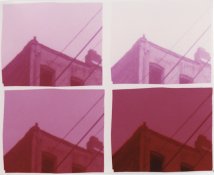bvy
Member
I'm trying to print (RA-4) a cross-processed frame of Fujichrome T64 onto Fuji Crystal Archive paper. I need some direction as it relates to filtration. Attached is a test strip using my regular starting filtration of 50M+50Y. Also shown is a full frame scan of the negative, which is what I'm trying to match as closely as possible. So I'm, of course, expecting a red or magenta cast in the final print, but not to the degree that I'm getting with this filtration. The window, for instance, should be in black shadow. Intuition tells me to boost the magenta filtration. But I feel like I should be doing something with the cyan filtration since I'm not dealing with the usual orange mask. The negative, when viewed in hand, is green.

50M+50Y, each frame 1 stop

negative scan
Thanks.

50M+50Y, each frame 1 stop

negative scan
Thanks.











